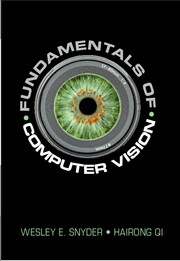Book contents
- Frontmatter
- Dedication
- Contents
- Preface
- For the Instructor
- Part I Preliminaries
- Part II Preprocessing
- Part III Image Understanding
- Part IV The 2D Image in a 3D World
- A Support Vector Machines
- B How to Differentiate a Function Containing a Kernel Operator
- C The Image File System (IFS) Software
- Author Index
- Subject Index
Part II - Preprocessing
Published online by Cambridge University Press: 25 October 2017
- Frontmatter
- Dedication
- Contents
- Preface
- For the Instructor
- Part I Preliminaries
- Part II Preprocessing
- Part III Image Understanding
- Part IV The 2D Image in a 3D World
- A Support Vector Machines
- B How to Differentiate a Function Containing a Kernel Operator
- C The Image File System (IFS) Software
- Author Index
- Subject Index
Summary
When the authors first started in Computer Vision, our intention was to write programs using the highest level, most elegant, most sophisticated Artificial Intelligence methods known. Of course, nothing worked.
Images are never what you expect. Real images all have noise. Even a perfect digital image is sampled, and sampling itself introduces a type of noise. Then there is blur and other distortions.
We begin this Part of the book by looking at the issue of finding edges in noisy images. That chapter will not only show how to find edges; it will introduce some other basic topics in image manipulation such as convolution.
Then, we move into removing noise. Blurring an image will certainly remove noise. Of course, it will remove image content also. The trick is to remove the noise but preserve image details, and that topic is discussed in the next chapter.
The final topic in this Part is morphology, a collection of nonlinear methods for erasing small details and closing gaps. The distance transform, a compact and useful representation for the information in an image, is also included in the morphology chapter.
- Type
- Chapter
- Information
- Fundamentals of Computer Vision , pp. 49 - 50Publisher: Cambridge University PressPrint publication year: 2017

